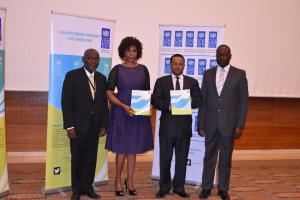Almost 60% of people in Sub-Saharan Africa experience deprivation, which systemically left them behind from the development gains, a UN report said.
“Sub-Saharan Africa remains burdened by the world’s most uneven distribution of development gains,” said 2016 Human Development Report (HDR) launched by the United Nations Development Programme (UNDP) in Addis Ababa this morning.
“Women and girls, rural dwellers, indigenous peoples, ethnic minorities, people with disabilities, migrants and refugees are among those systematically excluded by barriers that are not purely economic, but political and cultural,” the report said.
It stated that in Sub-Saharan Africa over the past two decades, almost 60% of people still experience deprivation. Around a third of children under the age of five are malnourished and affected by stunting. Gender inequality remains a serious challenge. Over 35% adults are illiterate. Some 70% of working adults earn less than $3.10 per day, according to the report.
Multidimensional poverty
The breadth of deprivation (intensity) in Ethiopia, which is the average deprivation score experienced by people in multidimensional poverty, is 60.9 percent, according to the report that compares Ethiopia with Rwanda and Uganda who are in better share scoring 47 and 51.1, respectively.
Households with a deprivation score greater than or equal to 50 percent live in severe multidimensional poverty.
“A deprivation score of 33.3 percent (one-third of the weighted indicators) is used to distinguish between the poor and nonpoor. If the household deprivation score is 33.3 percent or greater, the household (and everyone in it) is classified as multidimensionally poor. Households with a deprivation score greater than or equal to 20 percent but less than 33.3 percent live near multidimensional poverty,” the Report said.
Multidimensional Poverty Index (MPI) is calculated for 102 developing countries in the 2015 HDR. The 2010 HDR introduced the MPI, which identifies multiple overlapping deprivations suffered by households in 3 dimensions: education, health and living standards.
The education and health dimensions are each based on two indicators, while standard of living is based on six indicators. The Report stated that all of the indicators needed to construct the MPI for a country are taken from the same household survey. The indicators are weighted to create a deprivation score, and the deprivation scores are computed for each household in the survey.
Speaking at the launching, “The world’s citizens are not benefiting from equitable and universal access to quality education, healthcare social protection, universal respect for human rights and dignity remains a challenge,” said Ahunna Eziakonwa-Onochie, UN resident Coordinator, UNDP Resident representative & UN Humanitarian Coordinator in Ethiopia.

“It shows that income poverty only tells part of the story. The multidimensional poverty headcount is 54.7 percentage points higher than income poverty. This implies that individuals living above the income poverty line may still suffer deprivations in education, health and other living conditions,” the Report said.
The 2016 Human Development Report (HDR) focuses on how human development can be ensured for every one—now and in future. The Report explores who has been left behind in human development progress—and why.

